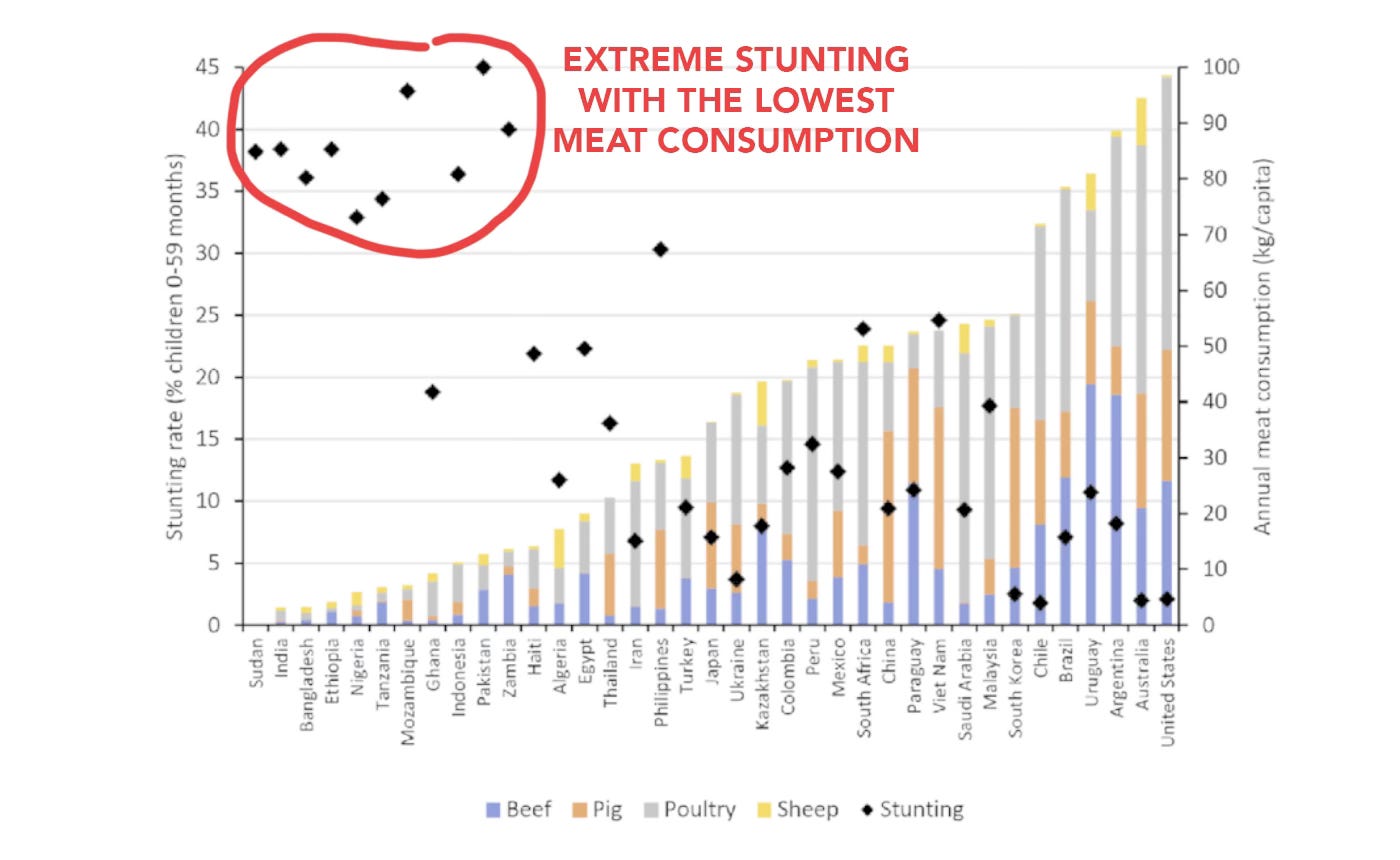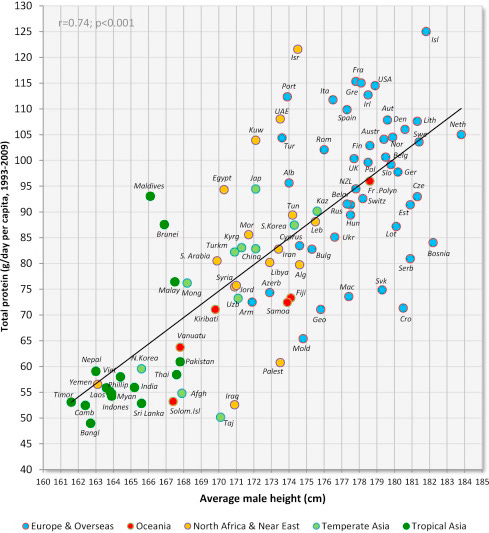How Meat & Milk Affect Height & Health
How Quality Protein & Nutrients Influence Population-Level Height
Height has long been seen as an indicator of overall health and well-being. Over time and across the globe, populations that have access to quality protein sources—especially from meat and dairy—tend to be taller. The correlation between population-level height and quality protein & nutrient consumption is not just a coincidence; it’s rooted in the nutritional science of growth and development. Let's dive into how this relationship has played out historically and across different countries, backed by a robust body of scientific studies.
*New addition for people coming to this post from my latest Instagram reel - here’s the link to the page with all the new data I found.
Correlation, Causation, and the Power of Nutrition
When we discuss the relationship between diet, height, and health, it's important to distinguish between correlation and causation. Yes, there's a clear correlation between the distance from the equator, animal protein consumption, and population height. Populations in northern regions, where diets are traditionally rich in meat and dairy, tend to be taller and generally enjoy better health outcomes compared to populations closer to the equator, where diets are often more plant-based. However, correlation does not necessarily imply causation.
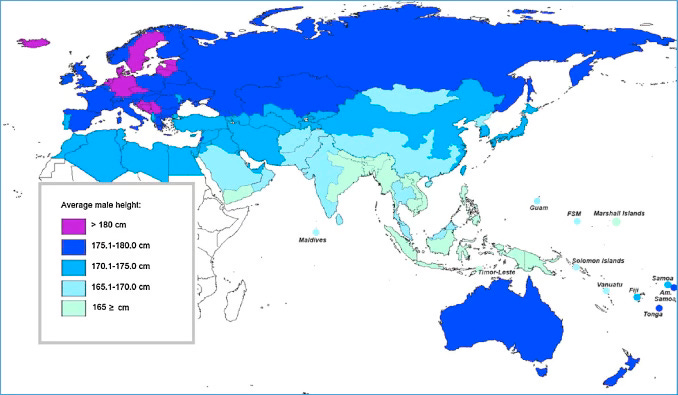
But, if we dig deeper into the available evidence, a compelling case emerges that suggests nutrition—specifically the consumption of animal protein and dairy—plays a causative role in enabling populations to reach their full height potential. This isn't just about surface-level correlations; it's about understanding how the bioavailability of essential nutrients in animal products influences growth and development at a fundamental level.
In the scientific literature, it's consistently observed that “height is a proxy for overall health and well-being.” Height is also linked to cognitive achievement, with studies showing that taller children “do better on cognitive tests and live longer.” Furthermore, height is associated with a myriad of health and well-being outcomes” including the health of future offspring. We'll explore more on how height serves as an indicator of health and thriving later in this article.

The Nutritional Science of Growth: Why Animal Protein and Dairy Matter
To build a strong case for causation, we need to look at the unique nutritional profile of animal protein, nutrients, and dairy products. These foods are powerhouses of bioavailable proteins, essential vitamins, and minerals that are critical for human growth, especially during childhood and adolescence.
Animal proteins are "complete" proteins, meaning they contain all nine essential amino acids that the body cannot synthesize on its own. These amino acids are vital for the synthesis of growth hormones and the development of lean muscle mass, which directly influences height. Moreover, animal proteins are highly bioavailable, meaning that the body can efficiently absorb and utilize these nutrients. This contrasts with many plant-based proteins, which may lack one or more essential amino acids and often have lower bioavailability due to the presence of anti-nutrients like phytates.
Dairy products, in particular, are rich in calcium, vitamin D, and insulin-like growth factor 1 (IGF-1), all of which play crucial roles in bone growth and overall height development. Calcium is the primary building block of bones, while vitamin D enhances calcium absorption and supports bone health. IGF-1, naturally present in milk, is a hormone that stimulates bone growth and has been shown to correlate with increased height in children who consume dairy regularly.

The Science of Height, Genetics, and Protein
Height is largely determined by genetics, but environmental factors, particularly nutrition, play a crucial role in expressing genetic potential. It's important to understand how our genetics have been shaped by diet and environment, especially when we consider the impact of an event like the Toba Constriction.
Approximately 75,000 years ago, the eruption of Mount Toba in Indonesia led to a global volcanic winter, drastically reducing the human population to around 10,000 to 30,000 individuals. This event, known as the Toba Constriction, was a bottleneck in human evolution, meaning that the genetic diversity we see today has its roots in this small population. Since then, our genetics have been significantly molded by diet and environmental factors as human populations spread across the globe.
The diets and environments of our ancestors have played a crucial role in shaping our genetic makeup, including traits like height. While our genetics do play a role in determining height, the importance of nutrition, especially quality protein intake, cannot be overstated. This is how environmental and dietary factors have historically influenced and continue to influence population-level height differences across the world. This was only about 3,000 generations of humans yet it led to the huge diversity in height and health we see today.
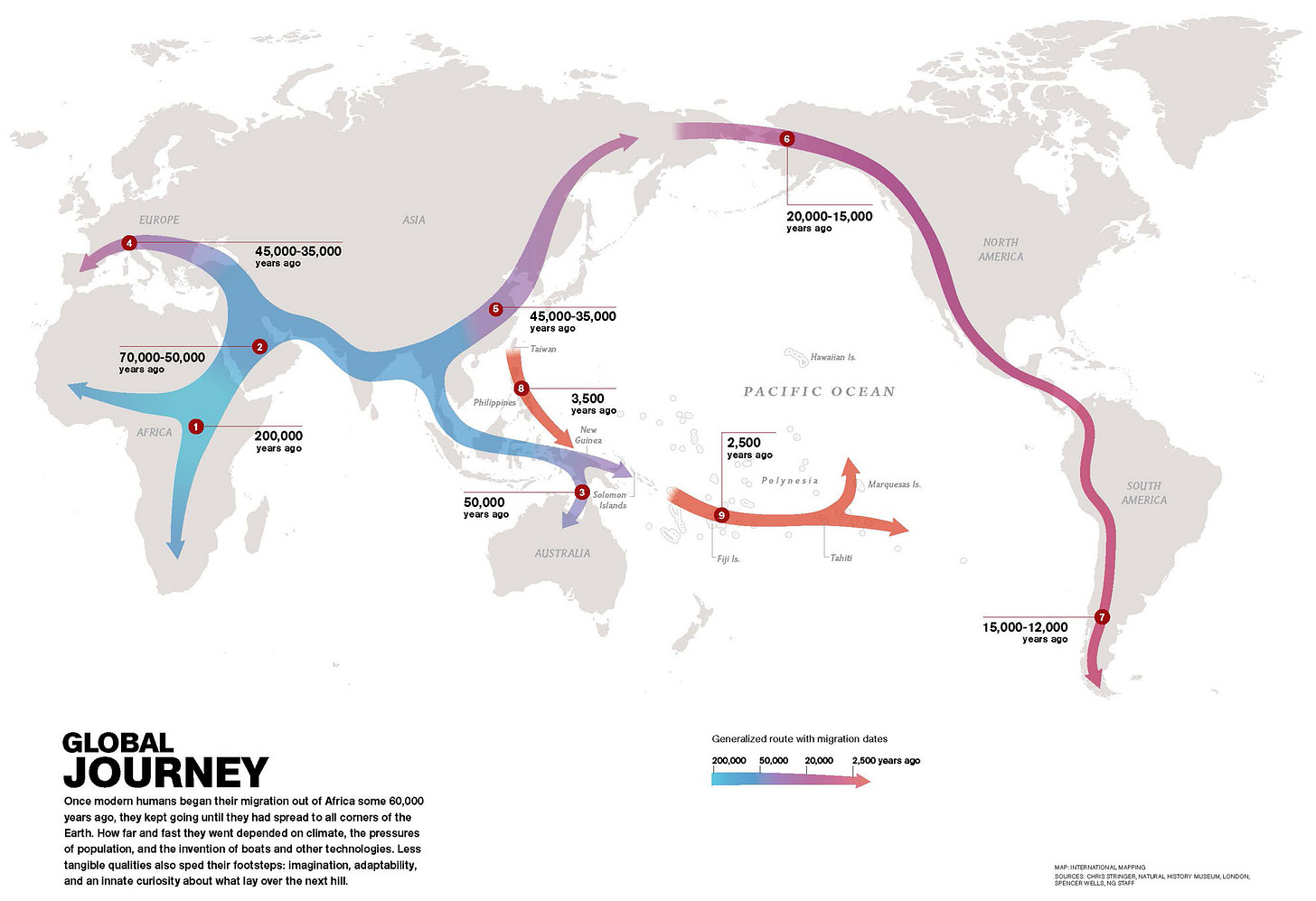
Historical and Cross-Country Comparisons
1. The Dutch Growth Spurt
In the late 19th and early 20th centuries, the Dutch experienced a remarkable increase in average height, making them the tallest people in the world today. This change coincided with a significant increase in the consumption of high-quality protein and nutrients, particularly from dairy products. The Netherlands became one of the world’s top dairy producers, and the availability of milk, cheese, and other dairy products became widespread across the population. Studies have shown that this increase in protein-rich dairy consumption was a major factor in the growth of Dutch stature.
2. Japan’s Post-War Diet Transformation
In the years following World War II, Japan experienced significant dietary changes, including an increase in meat and dairy consumption. Prior to the war, the Japanese diet was predominantly plant-based, and the population was notably shorter compared to Western countries. However, as meat and dairy became more integrated into the Japanese diet, a noticeable increase in average height was observed among subsequent generations. Research has attributed this growth spurt to improved access to complete proteins, which were previously lacking in the traditional Japanese diet.
3. North vs. South Korea: A Stark Contrast
The Korean Peninsula offers a unique natural experiment in the role of diet on height. Despite sharing the same genetic heritage, there is a significant height difference between North and South Koreans, with South Korean children being up 5 inches (13cm) taller. This difference can be largely attributed to the divergent diets in these two countries. South Korea's diet, rich in meat and dairy, contrasts sharply with the more restricted, plant-based diet in North Korea, where animal protein is scarce. The resulting height disparity is a clear demonstration of the impact of dietary quality on growth.
4. The Maasai and Kikuyu tribes
A striking example of how diet impacts height and health is found in the Maasai and Kikuyu tribes of Kenya. Despite sharing nearly identical genetics, the Maasai are, on average, about 5 inches taller than the Kikuyu. The Maasai's diet, rich in animal products like meat, milk, and blood, provides high levels of bioavailable protein, calcium, and other nutrients that contribute to their greater height and robust health. In contrast, the Kikuyu, who rely on a primarily plant-based diet with lower protein and nutrient density, are shorter and less physically developed.
5. The Historical Case of the United States
In the 19th and early 20th centuries, the United States saw a surge in average height as the country’s agricultural productivity grew, leading to increased consumption of meat and dairy products. Americans became among the tallest people globally during this period. However, in recent decades, the rate of height increase has slowed compared to other developed countries, possibly due to the rise in processed food consumption and a decline in the nutrient density of the average diet.
The Impact of Low Animal Protein Intake on Stunted Growth
Numerous studies have documented the adverse effects of low animal protein consumption on childhood growth, leading to stunted growth—a condition where children do not reach their full height potential. Stunting is particularly prevalent in regions where access to animal protein is limited, such as in parts of sub-Saharan Africa, South Asia, and Latin America.
Meat consumption and stunted growth (2019):
A 2019 study published in Global Food Security examined the relationship between meat consumption per capita and stunting rates across different countries. The study showed a clear inverse relationship: countries with lower per capita meat consumption had significantly higher rates of childhood stunting. While other socioeconomic factors may be at play here, the data is striking.
Animal Sourced Food and Child Stunting (2018):
A study looking at childhood stunting across 49 countries found that children in low- and middle-income countries who had diets low in animal protein were significantly more likely to experience stunted growth. The researchers emphasized that the lack of essential amino acids from animal proteins hindered the production of growth hormones, which are critical for normal growth and development. This study underlined the importance of animal-source foods in preventing stunting and promoting healthy growth.
Animal-Source Protein and Improved Height (2019):
Another study published in Frontiers in Nutrition highlights the impact of animal-source foods on growth and development, particularly in young children. The researchers found that children who consumed more animal-source foods, including meat, eggs, and dairy, exhibited significantly better growth outcomes compared to those with lower intake of these foods. The study emphasizes that animal-source foods provide essential nutrients, such as high-quality proteins, vitamins, and minerals, which are critical for achieving optimal growth and reducing the risk of stunting in early childhood. This further reinforces the vital role of animal-based nutrition in supporting healthy development.
Dairy's Role in Helping Humans Reach Their Full Height Potential
Dairy products, in particular, have been extensively studied for their role in promoting height growth during childhood and adolescence. Milk, rich in calcium, high-quality proteins, and growth-promoting hormones like insulin-like growth factor 1 (IGF-1), is a key dietary component that supports bone growth and overall height development.
Unsweetened Dairy and Growth (2021):
A study in The Journal of Nutrition found that regular consumption of unsweetened dairy products is positively associated with linear growth in children, highlighting dairy's role in helping achieve optimal height.
Milk and Dairy Meta-Analysis (2021):
A meta-analysis in European Journal of Clinical Nutrition showed a dose-dependent in dairy use: the more dairy consumed, the taller the children grew.
Dairy and Bone Development (2019):
A study in Frontiers in Nutrition showed that higher dairy intake in children leads to better bone density and linear growth.
Dairy and Genetic Height Potential (2020):
Research in Scientific Reports found that children with higher dairy intake were more likely to reach their genetic height potential, suggesting dairy’s critical role in maximizing growth.
Height, Nutrition, and Geographic Variation
Height variation across different regions of the world is closely tied to dietary patterns, particularly the consumption of animal proteins. Studies have shown that people living closer to the equator tend to be shorter on average than those living in northern regions, where diets are richer in meat and dairy.
A Century of Trends in Adult Human Height (2016):
A study published in Nature by NCD Risk Factor Collaboration analyzed height data from 18.6 million participants across 200 countries and found a clear geographic trend: populations in Northern Europe and North America, where diets are traditionally high in animal proteins, are among the tallest in the world. In contrast, populations in Southeast Asia, Central America, and sub-Saharan Africa, where diets are more plant-based with limited meat and dairy consumption, tend to be shorter on average. The researchers emphasized that while genetics play a role, environmental factors, particularly diet, are crucial in determining average population height.
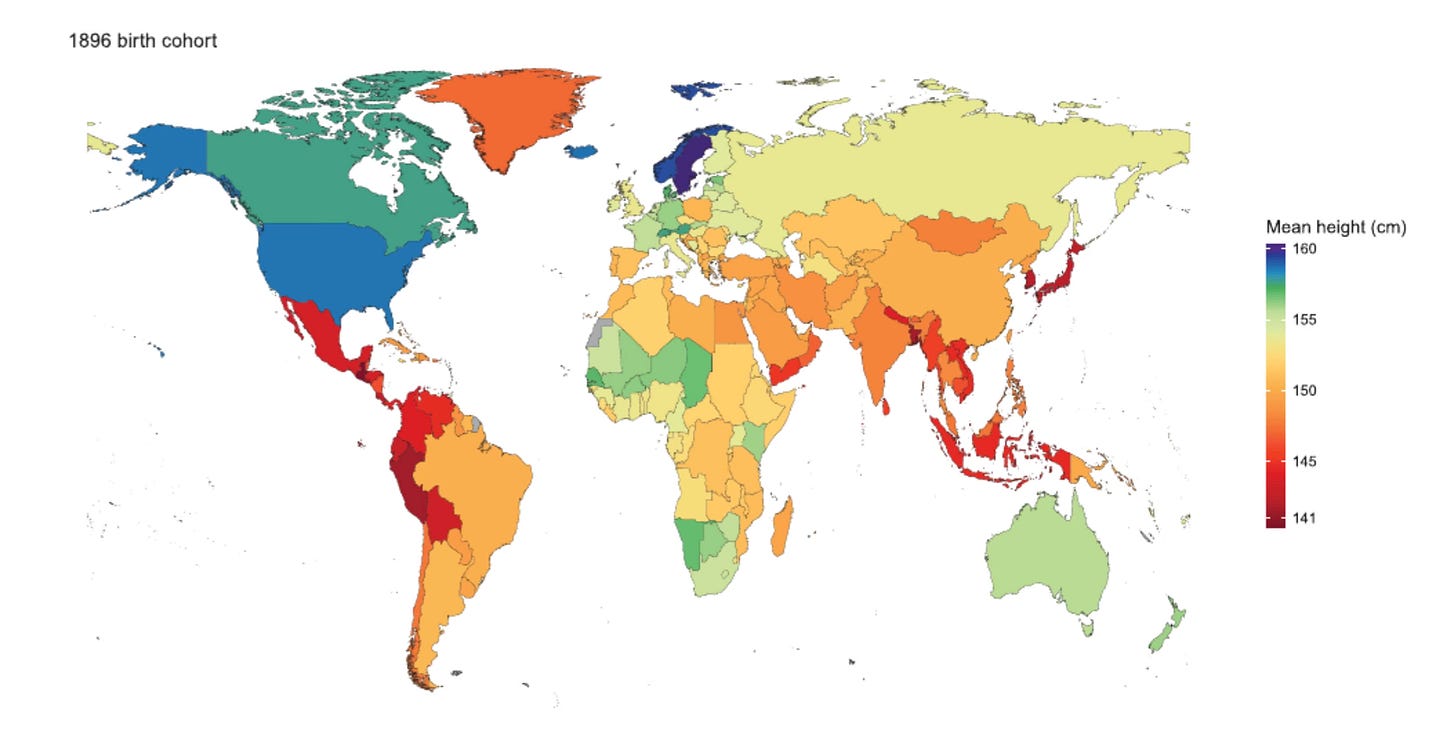
A 2016 study published in Economics & Human Biology
further elucidates the relationship between total protein consumption and average male height across 105 countries. The findings reveal a clear linear relationship: populations that consume more total protein, particularly from animal sources, tend to have taller average male heights.
The relationship between height and health is further underscored in a 2019 study published in Economics & Human Biology,
which found a strong correlation between height and health outcomes. The study highlighted that taller individuals generally experience better overall health, lower rates of chronic diseases, and higher life expectancy. This correlation is believed to be due to the cumulative effects of better nutrition, including higher intake of quality proteins, during critical growth periods.
The same study also discussed how the geographic disparity in height reflects broader nutritional differences. In regions where diets are rich in animal proteins, particularly in northern climates, people not only achieve greater heights but also exhibit better health outcomes. Conversely, in equatorial regions, where diets are less protein-rich, populations tend to be shorter and face higher rates of malnutrition-related health issues.
Why Aren’t the Inuit Taller?
Despite their animal-rich diet, the Inuit people are not particularly tall, which can be attributed to a combination of genetic adaptation, environmental factors, and specific dietary characteristics. Their diet, heavily based on seafood, is lower in calcium and other nutrients abundant in land-based animal products like beef and dairy, both of which are essential for bone growth and height. The limited access to dairy, a key source of calcium, vitamin D, and high-quality proteins, likely contributed to their shorter stature. Additionally, the Inuit’s adaptation to the Arctic environment, favoring a stockier build for heat conservation, also plays a role. The low carbohydrate intake in their traditional diet, similar to ketogenic diets that have been associated with stunted growth in children, may have further influenced their height.
The Role of Vitamin D and Dairy Deficiency
A deficiency in vitamin D, crucial for bone development, is another factor influencing the Inuit’s shorter stature. The low angle of the sun in the Arctic limits their natural production of vitamin D, and their year-round clothing further reduces sun exposure. Combined with their limited dairy intake, which is a significant source of both calcium and vitamin D, this deficiency likely impacted their growth. While the Inuit diet includes some vitamin D from fatty fish, it may be insufficient compared to populations with greater sun exposure and access to dairy, highlighting the role of both environmental factors and diet in shaping their physical characteristics.

The Interplay of Genetics, Nutrition, and Environment
The evidence is compelling: access to high-quality protein and nutrients, particularly from animal sources like meat and dairy, is a crucial factor in determining population-level height. While genetics undoubtedly influence height, it's essential to understand that our genetic makeup has been shaped by diet and environment over thousands of years. Also don’t forget that it’s not just about being taller - reaching your full height potential from optimal nutrition is also shown to align with greater health and intelligence.
This doesn’t mean that simply eating more meat and dairy will make someone taller. However, consuming enough of these nutrient-rich foods can help you reach the full height potential determined by your genetic inheritance.
Most nutrition experts can agree that eating a diet based on whole foods while avoiding processed foods is the key to health. But many try to push us towards the plant-based direction. Hopefully after seeing this evidence you’ll see that for humans to truly thrive we need an abundance of animal protein and nutrients. It may be hard to prove this with our modern, short-term studies, but when you look at thousands of generations the answer becomes clear.
-Brian Sanders
p.s. if you enjoyed this article, check out my Food Lies docuseries intro and get updates on when it will be released on my @food.lies Instagram
p.p.s. please consider supporting my writing/research by becoming a paid subscriber :)





